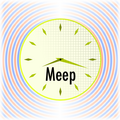Meep Tutorial/Band diagram, resonant modes, and transmission in a holey waveguide
From AbInitio
(diff) ←Older revision | Current revision | Newer revision→ (diff)
| Meep |
| Download |
| Release notes |
| FAQ |
| Meep manual |
| Introduction |
| Installation |
| Tutorial |
| Reference |
| C++ Tutorial |
| C++ Reference |
| Acknowledgements |
| License and Copyright |
In this example, we will consider the two-dimensional structure shown above, which is based on a system considered in:
- S. Fan, J. N. Winn, A. Devenyi, J. C. Chen, R. D. Meade, and J. D. Joannopoulos, "Guided and defect modes in periodic dielectric waveguides," J. Opt. Soc. Am. B. 12 (7), 1267-1272 (1995).
In particular, there are three basic ideas behind this structure, which we briefly summarize here.
First, by taking a dielectric wavgeuide and perforating it with a periodic sequence of holes, we form a kind of photonic crystal: there are still index-guided modes propagating losslessly down the periodic waveguide, but there is also a (partial) photonic band gap: a range of frequencies in which no guided modes exist.
Second, by making a defect in the periodic sequence, in this case by separating one pair of holes by a greater amount, we can trap a resonant cavity mode: it is localized along the waveguide direction by the band gap, and (partially) in the transverse direction by index-guiding. Because there is no complete gap, however, the mode has some intrinsic radiative losses: even with infinitely many holes/periods, it leaks away slowly into the surrounding air.
Third, by making a sequence of: ordinary (no holes) waveguide, periodic structure, defect, periodic structure, waveguide, we can make a filter. In particular, because there is now a finite number of holes, the resonant mode can now leak into the waveguide as well as to the surrounding air. Then, input light from the waveguide at the resonance frequency undergoes resonant coupling, and is transmitted to the other side with a Lorentzian transmission spectrum. In the limit where the resonant mode couples much more strongly with the waveguide than the air (i.e. if there are not too many holes and the radiative leakage is slow), then in a symmetric structure we should get 100% transmission on resonance, forming a narrow-band filter.
In the following, we will analyze the structure in exactly the opposite order of what we really should do. Really, we should analyze the periodic system first to understand the band gap, then analyze the resonant mode, and then finally analyze the transmission spectrum. Since all of those calculations have already been done in the above paper, however, we can jump straight to the transmission spectrum (which is conceptually the easiest computation to understand) and work backwards.


